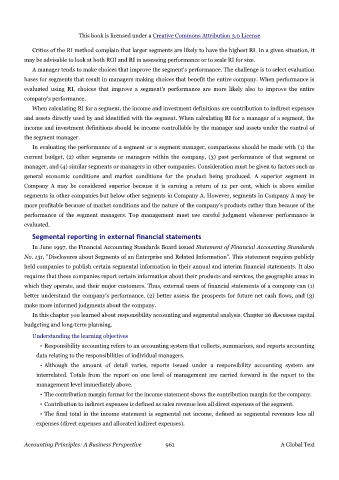Page 960 - Accounting Principles (A Business Perspective)
P. 960
This book is licensed under a Creative Commons Attribution 3.0 License
Critics of the RI method complain that larger segments are likely to have the highest RI. In a given situation, it
may be advisable to look at both ROI and RI in assessing performance or to scale RI for size.
A manager tends to make choices that improve the segment's performance. The challenge is to select evaluation
bases for segments that result in managers making choices that benefit the entire company. When performance is
evaluated using RI, choices that improve a segment's performance are more likely also to improve the entire
company's performance.
When calculating RI for a segment, the income and investment definitions are contribution to indirect expenses
and assets directly used by and identified with the segment. When calculating RI for a manager of a segment, the
income and investment definitions should be income controllable by the manager and assets under the control of
the segment manager.
In evaluating the performance of a segment or a segment manager, comparisons should be made with (1) the
current budget, (2) other segments or managers within the company, (3) past performance of that segment or
manager, and (4) similar segments or managers in other companies. Consideration must be given to factors such as
general economic conditions and market conditions for the product being produced. A superior segment in
Company A may be considered superior because it is earning a return of 12 per cent, which is above similar
segments in other companies but below other segments in Company A. However, segments in Company A may be
more profitable because of market conditions and the nature of the company's products rather than because of the
performance of the segment managers. Top management must use careful judgment whenever performance is
evaluated.
Segmental reporting in external financial statements
In June 1997, the Financial Accounting Standards Board issued Statement of Financial Accounting Standards
No. 131, "Disclosures about Segments of an Enterprise and Related Information". This statement requires publicly
held companies to publish certain segmental information in their annual and interim financial statements. It also
requires that these companies report certain information about their products and services, the geographic areas in
which they operate, and their major customers. Thus, external users of financial statements of a company can (1)
better understand the company's performance, (2) better assess the prospects for future net cash flows, and (3)
make more informed judgments about the company.
In this chapter you learned about responsibility accounting and segmental analysis. Chapter 26 discusses capital
budgeting and long-term planning.
Understanding the learning objectives
• Responsibility accounting refers to an accounting system that collects, summarizes, and reports accounting
data relating to the responsibilities of individual managers.
• Although the amount of detail varies, reports issued under a responsibility accounting system are
interrelated. Totals from the report on one level of management are carried forward in the report to the
management level immediately above.
• The contribution margin format for the income statement shows the contribution margin for the company.
• Contribution to indirect expenses is defined as sales revenue less all direct expenses of the segment.
• The final total in the income statement is segmental net income, defined as segmental revenues less all
expenses (direct expenses and allocated indirect expenses).
Accounting Principles: A Business Perspective 961 A Global Text

